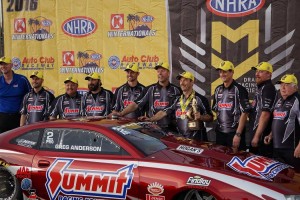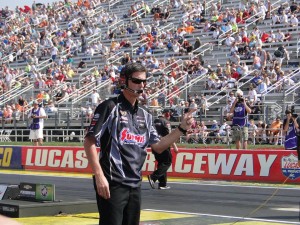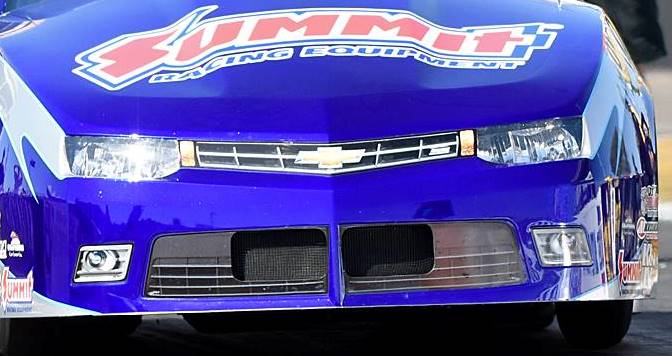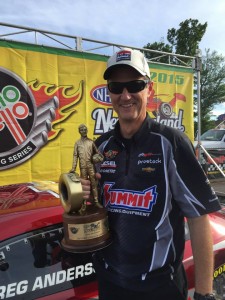Like anyone who competes in drag racing, Rob Downing has experienced a wide range of emotions since becoming an NHRA crew chief in 1998. During his 13 years as crew chief of the Summit Racing-sponsored KB Racing Pro Stock team of Greg Anderson and Jason Line, those emotions have been overwhelmingly positive thanks to team’s six World Championships and over 100 event wins.
But when the NHRA announced changes, including new EFI (fuel injection) and rev limiter rules, for the 2016 season, Downing experienced an unfamiliar emotion: fear.
“My first reaction—I was kind of angry about it to be honest with you,” said Downing, who joined KB Racing in 2003. “We really didn’t want to change because we felt like things were going pretty good from our end. That was the first reaction. The second one was probably fear—fear of all the stuff we had to change and how we were going to get it all done before the Pomona race.”
Downing and the KB Racing team are further proof that fear can be a great motivator. The team is off to an incredible start with the new EFI setup, winning the first two races of the 2016 season. Anderson took the win at the NHRA Winternationals in Pomona in a 1-2 finish with teammate Line, and Line earned his first Wally of the year the following race in Phoenix. The team’s smooth start to the season belies a turbulent off-season full of steep learning curves, trial-and-error, testing, and lots of unknowns.
And Rob Downing was in the middle of it all.
We talked to Downing to get a longtime crew chief’s perspective on the NHRA’s massive Pro Stock rule changes and how the team has managed to tackle the challenge.
OnAllCylinders: After initially being upset about the changes, what was the team’s reaction to the new rules?
Downing: We kind of went full circle. We went from being upset about it, to trying to figure out how we’re going to do it, to embracing it and enjoying it in the end. Like I’ve told people before—this is what we do. When you give us something like this, it’s my job to lay out the plan and figure out how to do it and get it all done. In the end, we enjoyed it because it was a challenge. And it felt really good when we came out and ran the way we did in Pomona.
OnAllCylinders: As a crew chief, where do you even begin with a massive change like this?
Downing: They announced the rules changes at the Denver race (July, 2015). Right at that point, you start looking at everything. Unfortunately, there weren’t parts to be purchased so it was kind of hard to get started at that point.
OnAllCylinders: Since the impending changes were announced in the middle of the year, did you catch yourself looking ahead to the next season?
Downing: To be honest, we spent a little time and looked at the things that had to be done before the end of the year. The one thing for us is it’s a 12-week lead time on rear-end gears, and the rpm limit led to us having to purchase all new rear-end gears. That was the main target—getting all the stuff that had to be ordered before the end of the year. But to be totally honest, we didn’t dyno our first engine until after Pomona (November, 2015). We had everything in the queue so to speak, but really didn’t spend a whole lot of time working on things while we were still racing, because we had a decent year going and were heading into “The Chase” with some real high hopes.
OnAllCylinders: What was the most challenging part of physically redesigning the car?
Downing: From the car standpoint, the big thing was getting the air duct. Until we got that, we couldn’t do anything. Fortunately, K&N was able to get through their design process and get us a development part within two weeks of Pomona. Once we got that, everything else kind of fell together. The biggest challenge was just getting everything put together—getting all the parts and figuring out how to do all the wiring.
Every single person on this team contributed to this deal in one way or another. We had car guys working on engines and engine guys working on cars. We had so much to do because we did the car conversions ourselves as far as modifying the front-ends, modifying the chassis—we did all the engine work ourselves. It was just a lot of stuff. Every (team) had the same project to work on, and it made us feel really good to come out and run the way we did.
OnAllCylinders: After 17-plus years working on carbureted race car setups, what was your learning curve for working on EFI systems?
Downing: We’re still learning because we’re just scratching the surface of it. But we just kind of approached it like we’ve done anything else: We worked real hard on the dyno to get the thing running right, and we spent some time here in Mooresville getting the drivability right. It was just kind of trial by fire, and just learning by doing it. None of us here knew a single thing about EFI before we started, so we had a little outside help getting started and learning the basic tools of how to tune things. Since then, it’s been about just doing it and learning about what affects what.
The one thing we didn’t realize is how much the carburetor did on its own. EFI will do exactly what you want it to do, but you have to tell it exactly what you want it to do. We never had to think about things like the drivability or doing a burnout or how it’s going to run at every single rpm or throttle position, so you have to get much more finite with your tuning. Every little detail has to be right, and there are just uber-opportunities to screw things up!
OnAllCylinders: How has the 10.5 rev limiter rule impacted you and will it help the engines last longer now?
Downing: Right now, I’d say yes, the engines will last longer. We’ll continue to refine them and probably get back to where they’re on the ragged edge. As far as the challenges of the rev limit, it has certainly made the driver’s job that much more important, because we want to run the engine as high as we possibly can without hitting the limiter. So the shift points have gotten to be much more important. We want to run it as high as we can to maximize the curve, so to speak. So that’s been a challenge.
OnAllCylinders: How have the changes affected chassis setup?
Downing: From where we were last year, the power range and power curve is completely different. It hasn’t taken a major overhaul, but we’ve had to work on the car some to get it to work well with that new power curve.
OnAllCylinders: And what about the front-mounted air inlet—how has that impacted the overall performance so far?
Downing: That’s to be seen. That was one of the fears we had at the beginning—what will (the new intake location) do and how will it affect the engine? I’m sure it’s going to, but I’m not sure how big a deal it’s going to be. The biggest issue so far was just getting one and getting it fit to the car, but K&N has done just a phenomenal job with it. There was some fear of how much debris we’d take into the engine, but that hasn’t been an issue so far.

Greg Anderson and crew chief Rob Downing (third from right) celebrate the team’s historic win at the 2016 NHRA Winternationals.
OnAllCylinders: Were you surprised with how the cars performed right out of the gate in Pomona?
Downing: We were pleasantly surprised. We did test and ran similar to the other cars that were there. We went back and did more work on the engines and found a little bit more performance. It felt like we were going to be in good shape, but honestly didn’t think we were going to run the way we did. I was very pleasantly surprised to see what happened in Pomona.
OnAllCylinders: How important has the extra seat time been, especially with both guys going extra rounds?
Downing: It’s huge. For instance, in Pomona we had a really good weekend without any real issues. But in Phoenix, we struggled on Sunday with the racetrack. The biggest difference, for me, is we’re dealing with a lot of different power curves. As the track (changed) for us on Sunday, we were just not making near big enough adjustments to keep up with it. Having three cars there and being able to learn from all three of them is good. We’ve done this on one (car), [something else] on another, and it’s really exponentially helping our entire program.
OnAllCylinders: What do you make of the time differences in the class from top to bottom in the first two races?
Downing: From first to tenth, I’m surprised at how big of a gap there is. Obviously, some of the top teams have different challenges. The Elite team, for example, is taking on Mopar. So they’re starting from scratch, and I know they didn’t have all the equipment or all the parts they needed to start the season. They’ll be making huge gains as the weeks go by with that Mopar program. But yeah—I really was surprised there was that much of a variance in the top 10 teams.
OnAllCylinders: Where do you see times and speeds by the end of the season?
Downing: I don’t really have a prediction, but I will guarantee you this: By mid-season, the gap you’re seeing from one to 10 won’t be there. It will be tight. The teams in that position will certainly improve their performance and catch up with the upper teams. What the overall performance gain of the class will be, though? I don’t know. We’ll certainly make gains, but it will be different than other years, so I just don’t have a good answer for you there.
OnAllCylinders: How have race day tuning duties changed with the new EFI setup?
Downing: It’s similar, other than we’re doing it all with a computer now. Jason does 99 percent of the tuning, and we all help him out a little bit as we can. He’s still the one that has the heartbeat of the engine, so he knows what works and what doesn’t. I’ve been able to help him a little bit computer-wise, but he’s handled most of it. And again, instead of changing jets or adjusting anything carburetor-wise, he’s doing it with a laptop, so it’s been a learning curve. He’s done just a phenomenal job of figuring out where it needs to be.
OnAllCylinders: Have the shorter turnarounds from the live TV coverage made between-round tuning a little bit harder?
Downing: Honestly, NHRA has done a really good job of “training” us. Last year, when we started doing the live races, they pretty much ran it the same way almost every race to get us used to the timeframe. It’s tight, but it’s doable as long as we don’t have any major issues. At Pomona—with all the changes we had and all three cars going as far as they did—it got pretty busy there at the end. But it hasn’t been bad, really.
OnAllCylinders: So has this season been the biggest challenge you’ve ever faced as crew chief?
Rob Downing: Absolutely. It’s been a big project with a big learning curve. It’s been fun, though, and we’ve learned a lot. I certainly like to work on different ways of doing things, so the challenge has been the big thing. Me and Jason—we probably enjoy the development end of it as much or more than the racing, so it’s been fun. I’m just really proud of our team and how everyone has contributed to the project. Hogan’s Manifolds is also a big part of our performance right now. They’ve been great to work with and have gone above and beyond to help us. K&N has also done a great job in developing parts and getting the parts to us on a tight timeline. We’ve been fortunate with the ways things have worked out so far.




I really care for team Summit and KB Racing. I love these guys. BUT, I don’t care for all the new rules for this class. Wally Parks, RIP, would not have went for this. He is the man that began and ruled NHRA. I don’t care for this fellow that changed the world with his new rules. He has caused NHRA to loose many fans and supporters. Not to mention Millions of folks that watch Drag Racing on TV can’t see it no more because its not ESPN. Good luck to all KB Racing, Team Summit and keep your heads up and go out there and win all the way through 2106. God Bless you all. Thank you.
[…] Crew Chief Confidential: A Longtime Crew Chief’s Perspective on the NHRA’s Pro Stock Rule Change… […]